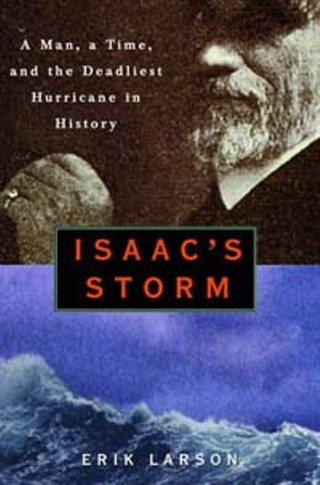Book Reviews
By Jesse Sublett, Fri., Oct. 29, 1999

Isaac's Storm: A Man, a Time, and the Deadliest Hurricane in History
by Erik LarsonCrown, 323 pp., $25
At the beginning of the 20th century, Galveston was one of the biggest ports in the South, expecting nothing less than continued prosperity from the bounty of the sea. After the hurricane of September 8, 1900 -- the deadliest that ever hit North America -- practically erased it from the map, killing between 6,000 and 10,000 people in the process, there was some reason to doubt the wisdom of locating a populous city on a spare spit of sand a mere six feet above sea level, connected to the mainland by only two bridges, both of which were navigable only by fishes by the time the residents realized they were in the wrong place at the wrong time. This storm and the people who suffered the brunt of it, as well as the era in which they lived -- its mood, its pace, its achievements, and its follies -- are the subject of a book that seems poised to ride the tidal wave of bestselling nature-adventure tales like Sebastian Junger's The Perfect Storm, Jon Krakauer's Into Thin Air, and a host of others.
What distinguishes Larson's chronicle of this oft-recounted event is his attempt to focus much of the story around Isaac Cline, the local Weather Bureau chief who, as the storm approached, rode down to the beach on horseback, trying to convince everyone that a powerful hurricane was about to strike the city. Earlier, however, Cline received reports that the hurricane had devastated Cuba, but firmly believed that Galveston was in no danger at all. Unfortunately, no one heeded Cline's words -- until it was too late. That night, Cline rode out the storm clinging to the floating wreckage of his house with the surviving remnants of his family. It's a story of high drama, tragedy, hubris, and one of Mother Nature's nastiest tantrums on record. Larson has a nifty way of layering neat factoids on the history of weather prediction, but it strikes me as incomprehensibly weird that such a book would be published with no illustrations whatsoever. Larson's colorful and too often purple prose does not make up for this deficit. Also, one of the book's overriding conceits -- that this was an era in which people had made such grand achievements that they believed they had power over nature itself -- seems awfully strained. Even if it were true then, are we really that much different today?
Erik Larson will read from Isaac's Storm on Sunday, November 7 at noon during the Texas Book Festival inTexas Capitol Extension Room E2.014.








